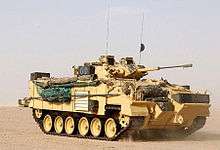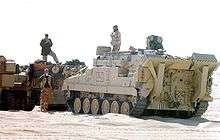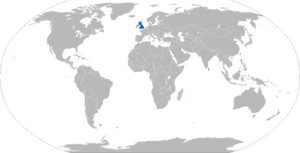Warrior tracked armoured vehicle
| FV 510 Warrior | |
|---|---|
|
FV510 Warrior Infantry Section Vehicle | |
| Type | Infantry fighting vehicle |
| Place of origin | United Kingdom |
| Service history | |
| In service | 1988–present[1] |
| Production history | |
| Designer | GKN Sankey / GKN Defence |
| Manufacturer | GKN Sankey/BAe Systems |
| Number built | 1,000+ |
| Specifications | |
| Weight | 25.4 tonnes |
| Length | 6.3 m (20 ft 8 in) |
| Width | 3.03 m (9 ft 11 in) |
| Height | 2.8 m (9 ft 2 in) |
| Crew | 3 (commander, gunner, driver) + 7 troops |
|
| |
| Armour | Aluminium and Appliqué |
Main armament |
30 mm L21A1 RARDEN cannon (current) |
Secondary armament |
L94A1 coaxial 7.62 mm chain gun 7.62 mm machine gun |
| Engine |
Perkins V-8 Condor Diesel 550 hp (410 kW) |
| Power/weight | 23.5 hp/t |
| Suspension | torsion bar |
Operational range | 410 miles (660 km) |
| Speed | 46 mph (75 km/h) on road, 31 mph (50 km/h) off road[2] |
The Warrior tracked vehicle family is a series of British armoured vehicles, originally developed to replace the older FV430 series of armoured vehicles. The Warrior started life as the MCV-80 project that was first broached in the 1970s, GKN Sankey/Defence winning the production contract in 1980. GKN Defence was subsequently purchased by BAE Systems (via Alvis plc). A total of 789 FV510 and variants were manufactured for the British Army, and 254 of a modified version (Desert Warrior) were produced for the Kuwaiti Army.
Description
The Warrior incorporates several design features in keeping with UK battlefield experience. In particular, there are no firing ports in the hull, in line with British thinking that the role of the armoured personnel carrier/infantry fighting vehicle (APC/IFV) is to carry troops under protection to the objective and then give firepower support when they have disembarked. The absence of firing ports also allows additional applique armour to be fitted to the sides of the vehicle, which is invariably applied to Warriors involved in active operations. The cage armour used at one stage was replaced in 2007 by "Wrap Two" applique armour.[3] The basic armour provides all-around protection against small arms ball ammunition.

The crew of a Warrior comprises the driver, seated in the front hull, and the gunner and commander, who are both seated in the turret. The embarked infantry section can number up to seven soldiers, who are seated facing each other in the rear hull compartment. Passenger access is through a single electric ram powered door at the rear of the hull, rather than a drop-down ramp as in the American M113 APC and M2 Bradley IFV. Warrior Section Vehicles are able to carry and support seven fully equipped soldiers together with supplies and weapons, including a number of anti-tank weapons, for a 48-hour battlefield day in nuclear/biological/chemical conditions.
The Warrior is driven by a Perkins-Rolls-Royce V8 Condor engine through a four-speed automatic gearbox. It is capable of a road speed of 46 miles per hour (74 km/h). The Warrior has the speed and performance to keep up with a Challenger 2 main battle tank over the most difficult terrain.
The vehicle is fitted with a two-man GKN Sankey turret, armed with a non-stabilized L21A1 30 mm RARDEN cannon capable of destroying most modern APCs at a maximum range of 1,500 metres (1,600 yd), and an L94A1 EX-34 7.62 mm Hughes Helicopters coaxial chain gun. It is fitted with two clusters of four defensive grenade launchers (usually used with Visual and Infrared Screening Smoke – VIRSS).
All Warrior Infantry Section Vehicles are now equipped with Bowman radios, which replace the earlier Clansman radios, for enhanced communications, command and control. When first introduced, the vehicles were fitted with passive Image intensifier night vision sights. These have since been progressively replaced with Thales Optronics Battle Group Thermal Imaging (BGTI) sights to upgrade night fighting capabilities, with 8x magnification.[2] As of 2007, 350 vehicles were fitted with BGTI.
Combat history
- Operation Granby (Gulf War)
- United Nations duties in Bosnia with the UNPROFOR
- Operation Telic (2003 invasion of Iraq)
- Operation Herrick (Afghanistan with ISAF)
The protection against small arms, missiles, rocket-propelled grenades and anti-tank mines was shown during the UN operations in Bosnia. Two Warriors were destroyed during the First Gulf War, with nine soldiers killed, in a friendly fire incident when hit by an AGM-65 Maverick launched in error by an American A-10 Thunderbolt II.
As of 17 November 2008, 22 soldiers had been killed while travelling in Warrior IFVs in Afghanistan or Iraq.[4]
On 7 March 2012, six British soldiers were killed in an explosion that hit a Warrior IFV in Helmand.[5]
Variants
- FV510 Infantry Section Vehicle. This is the principal version operated by the British Army, as described above. 489 were produced (including 105 as platforms for the mobility of ATGW teams, originally equipped with MILAN and later with Javelin).
- FV511 Infantry Command Vehicle. 84 of these were produced.

- FV512 Mechanised Combat Repair Vehicle. Operated by REME detachments in Armoured Infantry battalions. It is equipped with a 6.5 tonne crane plus power tools and is able to tow a trailer carrying two Warrior power packs or one Challenger power pack. 105 of these were produced.
- FV513 Mechanised Recovery Vehicle (Repair). Also operated by REME detachments in Armoured Infantry battalions. It is equipped with a 20 tonne winch and 6.5 tonne crane plus power tools and (like the FV512) is able to tow a trailer carrying two Warrior power packs or one Challenger power pack. 39 of these were produced.
- FV 514 Mechanised Artillery Observation Vehicle. This is operated by the Royal Artillery as an Artillery Observation Post Vehicle (OPV) and is fitted with mast-mounted Man-packable Surveillance and Target Acquisition Radar (MSTAR) and Position and Azimuth Determining System (PADS), with Image Intensifying and Infra Red equipment. The only armament is the 7.62 mm machine gun, as the 30 mm Rarden cannon is replaced by a dummy weapon. This allows space for the targeting and surveillance equipment while still keeping largely the same outward appearance of a standard Warrior in order to avoid becoming a priority target. 52 of these were produced.
- FV 515 Battery Command Vehicle. This is operated by the Royal Artillery. 19 of these were produced.
- Desert Warrior. This was an export version adapted for operations in hostile desert conditions. It was fitted with the Delco turret as used on the LAV-25 wheeled IFV, mounting a stabilised M242 Bushmaster 25 mm chain gun with coaxial 7.62 mm chain gun and 2 x Hughes TOW ATGM launchers (one mounted on each side). In 1993, Kuwait purchased 254 Desert Warrior vehicles.
- Warrior 2000. This was a new version developed for the Swiss Army. It did not enter production. It featured an all-welded aluminium hull, increased armour, digital fire control system and more powerful engine. It was fitted with the Delco turret, or a Land Systems Hagglunds E30 turret with Alliant Techsystems Bushmaster II Mk 44 30 mm cannon.
Warrior Capability Sustainment Programme

Upgrades already fitted to Warriors in British Army service include the Bowman Communications System and Thales Battle Group Thermal Imaging (BGTI) night sights. Future upgrades will include a digital fire control system and improved power pack.
The British Army intends upgrading its Warriors to extend their service life to 2025. The Warrior Capability Sustainment Program (WCSP) will involve upgrading 643 of its Warriors with the Warrior Modular Protection System (WMPS) and Warrior Enhanced Electronic Architecture (WEEA). Within that group, 449 vehicles will also be fitted with a new turret and weapon system under the Warrior Fightability Lethality Improvement Program (WFLIP). The remainder, which will be designated as Armoured Battlefield Support Vehicles (ABSV), will lack turrets and carry out field repair and recovery roles using winch and crane attachments.
Under the WFLI program, the present turret mounting the RARDEN cannon, which lacks stabilisation and is manually loaded with three-round clips, will be replaced by a turret that will mount a stabilised 40 mm weapon developed by the Anglo-French firm CTA International and firing Cased telescoped ammunition.[6][7] This weapon will also equip the Scout SV reconnaissance vehicle which is being developed.
BAE Systems and Lockheed Martin competed for the WCSP contracts. Lockheed Martin's WFLIP upgrade was based on the existing Warrior turret. BAE Systems designed a new turret.[8] In March 2011, it was announced that Lockheed Martin had effectively won the competition to develop both the WFLIP and FRES turrets. Severe budgetary pressures made it uncertain whether these defence projects were to be delayed or curtailed, but it was announced in October 2011 that the Warrior upgrades would proceed at a cost of one billion pounds, extending the service life of the Warrior to 2040 and beyond.[9][6] The scheduled in-service date for upgraded Warriors is 2018. SciSys will provide Lockheed Martin UK with platform management software to control systems to improve operational effectiveness.[10] It was reported in January 2015 that a whole new turret would have to be built for the WCSP.[11]
Operators

Current operators
-
 British Army – 789 received between 1987 and 1995.
British Army – 789 received between 1987 and 1995. -
 Kuwaiti Army – 254 Desert Warriors received.
Kuwaiti Army – 254 Desert Warriors received.
See also
- Tulpar IFV
- VCTP
- LAV-III
- ZBD-97
- ASCOD family of vehicles
- AMX-10P
- VBCI
- Schützenpanzer Marder
- Schützenpanzer Puma
- Dardo IFV
- Abhay IFV
- Mitsubishi Type 89 IFV
- K21
- Bionix AFV
- BMP-3
- Combat Vehicle 90
- M2 Bradley
Notes
- ↑ "MCV-80 Warrior Infantry Fighting Vehicle".
- 1 2 http://www.army.mod.uk/documents/general/285986_ARMY_VEHICLESEQUIPMENT_V12.PDF_web.pdf
- ↑ Army Technology : Warrior Tracked Armoured Vehicles
- ↑ The Telegraph : New safety fears over Army vehicles after soldier killed
- ↑ "Six UK soldiers killed in Afghanistan explosion". BBC. 7 March 2012. Retrieved 7 March 2012.
- 1 2 Anthony G Williams : Light AFV guns and the WFLIP project
- ↑ Youtube : Testing the Warrior IFV armed with new turret
- ↑ Defence Industry Daily.com retrieved 20 May 2013
- ↑ "£1bn upgrade for British army's Warrior vehicles". BBC News. 25 October 2011. Retrieved 25 October 2011.
- ↑ SciSys has won a contract to work with Lockheed Martin on upgraded Warrior armoured programme – Armyrecognition.com, 27 July 2013
- ↑ http://www.defensenews.com/story/defense/land/vehicles/2015/01/27/warrior-uk-capability-boost-lockheed-budget-army-turret-ctai/22398029/
References
- Foss, Christopher & Sarson, Peter. Warrior Mechanised Combat Vehicle 1987–1994, Osprey UK, 1994, London, New Vanguard Series No. 10.
External links
| Wikimedia Commons has media related to FV510 Warrior. |
| ||||||||||||||||||||||||||
